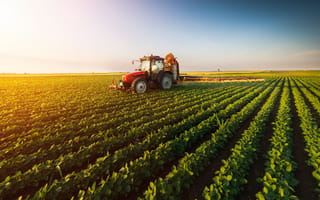Several years ago, Paul Mikesell noticed a pattern when he conversed with friends who work in the agricultural industry.
They all struggled with weed control. That’s how the veteran startup founder conceived an idea for a new technology venture that would help farmers protect their crops against weeds. This notion gave rise to Mikesell’s company, Carbon Robotics, and its first product, the Autonomous LaserWeeder.
While this self-driving robotic creation was effective, Mikesell and his team members weren’t satisfied. After gathering feedback, they learned that farmers desired machinery that could be easily implemented into their existing infrastructure.
Less than one year later, the company introduced an updated version of the LaserWeeder, which offers increased performance and operational compatibility with farmers’ tractor fleets. Mikesell believes this product evolution was made possible not only by powerful technology, but his team’s inherently ambitious and supportive nature.
“Carbon Robotics’ collaboration is built around the encouragement to take risks, even if they fail,” he said.
Powered by AI deep learning models and computer vision software, the company’s latest invention identifies, targets and eliminates weeds found in row crops, therefore removing the need for tilling, chopping or using herbicides. This new model has proven so successful that the company’s 2023 pre-orders sold out, and pre-orders for 2024 have been steadily rolling in.
As Carbon Robotics continues to develop LaserWeeders at a rapid pace, leadership is focused on finding more passionate, talented technologists to join their team and meet this growing demand. “We’re building a world-class team of stars and underdogs who are motivated by the challenge, are quick to iterate and work together to find the path forward,” Mikesell said.
Built In Seattle caught up with Mikesell to understand the teamwork and transformation that went into building the LaserWeeder as well as his views on inspiring ambition as a leader.
What led to the inception of LaserWeeder, and what feedback have you received from farmers so far?
I have a few friends who are farmers, and I deeply appreciate their hard work and the dedication they have for their profession. I also recognize the importance of their jobs –– they provide food security for the world. After speaking with these friends and other farmers, it became clear that weed control is a major — and accelerating — challenge in agriculture. This led me to found Carbon Robotics in 2018 in an effort to create a weed control solution that helps farmers grow quality food efficiently and sustainably.
The main feedback we’re hearing is that the LaserWeeder’s design integrates seamlessly into farming operations and expedites tedious weed management, both of which are two of our primary goals. Additionally, we’ve heard our product provides significant cost savings, with some farmers predicting savings of up to 80 percent. Our laser-weeding technology operates faster than a hand-weeding crew by detecting weeds much earlier than the human eye and eradicating them with millimeter accuracy.
What role did you play in developing the product, and what tools and technologies did your team use to build it?
I leveraged my background in deep learning and computer vision to build the first laser-weeding prototype using a handcart, laser and small camera. We used this pushcart to determine if laser-weeding was an effective method of weed elimination. Once we were able to prove the concept with results, I founded Carbon Robotics and began designing a farm-tough, high-performance machine. The pushcart laid the foundation for the technology and equipment we use today.
The LaserWeeder strictly leverages our sophisticated laser-weeding technology to efficiently identify, target and eliminate weeds found in row crops without the use of tilling, herbicides or chopping. It’s also equipped with high-precision cameras that work with deep learning models to pinpoint and eradicate the meristem of weeds with high-power CO2 lasers while avoiding the crops.
Additionally, we designed the LaserWeeder as a pull-behind implement that seamlessly attaches to the backs of tractors. This design allows it to integrate into existing infrastructure, so farmers can incorporate the tool into existing daily operations without the need for major adjustments or additional equipment.
As a leader, how did you keep team members motivated and aligned throughout the product development process?
I understand the level of innovation required to develop and market a new technology. From a leadership standpoint, I give people space to make mistakes and learn from them. My favorite motto is, “Do what you say you’re going to do.” With this level of transparency and accountability, I have instilled trust within my team, enabling us to launch two products within a year, close a Series B funding round, file multiple patents, set up a manufacturing facility, hold exhibits at numerous trade shows and build a sales organization.
I give people space to make mistakes and learn from them.”
How does Carbon Robotics compare to other organizations in your industry when it comes to building and launching new products?
Carbon Robotics is the only company with a commercial laser-weeding product. We’ve already filed multiple patents to protect our intellectual property on laser- weeding, computer vision and bed top lighting. We created our own software and datasets for the LaserWeeder in order to train the robots to perform precise laser targeting.
Our work ethic is partially defined by ensuring we provide efficient agtech tools for farmers, which is why we work directly with them to understand their needs. Following the launch of the Autonomous LaserWeeder, we learned that farmers were looking for machinery that could be easily implemented into existing infrastructure. As a result, we adapted the design and launched the latest LaserWeeder in under a year.
We’re a tight-knit team that encourages creativity across all departments. Through this continued innovation and creative freedom, we’re able to create industry-leading agricultural tools that are positively impacting farmers’ daily operations.







